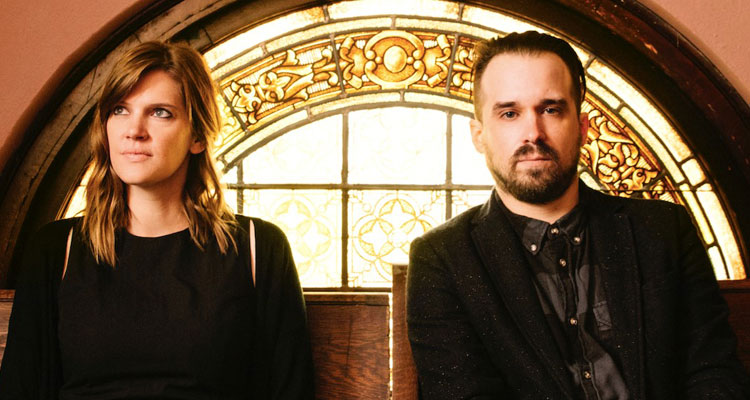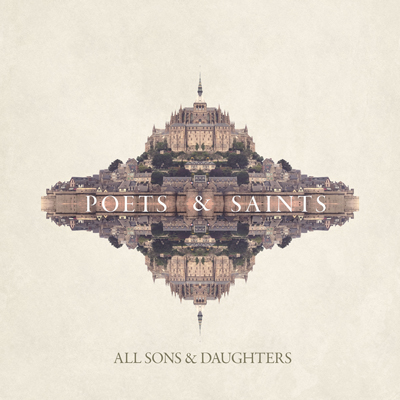We offer an exclusive song-by-song summary of All Sons & Daughters’ anticipated upcoming release, Poets & Saints (Sep. 2, 2016, Integrity Music—buy) as provided by lead members Leslie Ann Jordan and David Alan Leonard
“Heaven Meets Earth”
Oxford, England
Many scholars & theologians study his anthologies. Children find themselves traveling through the wardrobe into Narnia. Thousands comb the pages of Mere Christianity year after year for spiritual renewal.
C.S. Lewis’ influence spans a wide demographic. His work, oddly enough, seems to hold one thematic component; the mystery of God. His life & works were a reflection of his journey. From fantasies to faith, from war to freedom, or grief to the afterlife, Lewis knew how to draw on the power of the transcendent in all things. You see, Aslan is not just the name of a beloved Lion, He is the gentle but powerful image of our Creator. Singing Narnia into existence in The Magician’s Nephew, Aslan walks the earth and calls upon creation.
“Heaven Meets Earth” was written from that familiar scene in The Magician’s Nephew and the passage in Genesis where light meets darkness, sky meets water, and spirit meets flesh.
*As you listen, you will hear waves underneath the heartbeat drum. Those waves and heartbeat came from a recording on the beaches of Normandy, in particular Omaha Beach.
“My Roving Heart” and “The Path Of Sorrow”
Olney, England
A slave trader-turned pastor and a poet with a broken heart.
John Newton and William Cowper, two unlikely friends in the heart of the English countryside, wrote what is considered to be the very first church hymnal. Oddly enough, at the time of their creation, these hymns were not allowed inside the church. Their familiar pub melodies and honest lyrics were quite the departure from the traditional psalms being sung in the church at that time.
Newton’s life of slave trading & monetary excess provided great contrast for his transition into a life as a humble pastor & hymn-writer. He saw an opportunity for his young friend William Cowper, who regularly dealt with depression, to use his poetic prowess to create art for the church. This not only gave Cowper purpose, but it gave the church the gift of lament in common language. Together, they wrote over 300 hymns and compiled what we now know as the Olney Hymns.
“My Roving Heart” (straight from the Olney Hymns) is our attempt to marry the lyrics of John Newton’s hymn with modern pub-style melodies & instrumentation. These lyrics were written over one-hundred years ago and have a depth and richness that we long to see make their way back into the church and an air of celebration that we get to experience in the company of friends when praising the goodness of our God.
“The Path Of Sorrow,” adapted from a William Cowper lyric, draws on the strength of God in the midst of suffering. There is a steady beat—constant and strong—amidst the longing for relief. There is sincerity in the lyric and weeping in the instrumentation.
So steadily I keep my stride through every briar & thorn—although my flesh will falter, my hope is in the Lord.
 “You Are Love & Love Alone”
“You Are Love & Love Alone”
Saint Thérèse was fourteen when she became history’s youngest Carmelite nun. Known for “The Little Way,” Thérèse spent her short life learning how to be smaller so God could be bigger. She spent herself in the little deeds—glances, hugs, meals, prayer—knowing that God’s goodness is not only seen in the extravagant things we do. She died young at the age of twenty-four but her impact would be eternal. Regarded as one of the Catholic Church’s most influential Saints, Thérèse’s legacy of the little way lives on.
“You Are Love & Love Alone” is the modern adaptation of Frederic William Farar’s hymn, “Thou Art Love and Love Alone” and this quote from Saint Thérèse, “to love: how perfectly our hearts are made for this.” Musically, “You Are Love” is simple with the emphasis placed on the powerful words of the hymn. It is in the gathering of little things that we really understand how profound God’s love is for us.
“Rest In You”
Milan, Italy
“For who is Lord but the Lord?
Who is God except our God?
The highest.
The most good.
The most mighty.
The most omnipotent.
The most merciful, yet most just.
The most hidden, yet most present.
The most beautiful, yet strongest.
The stationary, yet incomprehensible constant.
You cannot change, yet You change everything.
You are matchless, O Lord.
So our praise of You must rise above our humanity.
You made us for Yourself, and our heart is restless until it finds its place of rest in You.”
Saint Augustine spent the first half of his life looking for fulfillment… in women, money, knowledge, and religion. Then, he met Jesus on a bench in Milan while reading Paul’s letter to the Romans. The design of his life was no longer in question; he was created with an eternal longing that would only be satisfied when Jesus restores this world. In his journal, Augustine gives words to his discovery and insight into his holy longing. We know it as Confessions.
“Rest In You” is Augustine’s journal entry put to music. Slow and peaceful, we know that our hearts are restless until they find rest in God and God alone. Nothing else but the eternal presence of God will satisfy our deepest longings.
“Creation Sings”
Geneva, Switzerland
Have you ever seen a mountain so tall that it hurts your neck to stare at it? Have you ever seen water so blue that it didn’t matter how cold it was, you had to jump in? Geneva, Switzerland was the backdrop of our exploration of the life of John Calvin. Known for his stance for or against certain things, Calvin’s name can quickly become the source of friendly religious debates. But our hope was to find something different within his story. And we did.
Calvin’s desire to express the creative nature of God in all things led him to bring excellence in music back to the church. Calvin himself was not a musician so he called upon outside professionals, skilled and trained, to change an apathetic musical culture into a symphony that might make you wonder if it came from Heaven itself.
“Creation Sings” is an adaptation of scripture with an arrangement of strings, which sound the way Geneva looks; bold, beautiful, inspiring. We found ourselves wondering how one could live in such a place of beauty and not want all things to reflect the same. Even the rocks cry out.
Editor’s note: Stay tuned to CCMmagazine.com and our social channels on Facebook, Twitter, and Instagram, as we will feature the remaining song synopsis from Poets & Saints in the August 15, 2016 edition of CCM Magazine!



Leave a Reply
You must be logged in to post a comment.